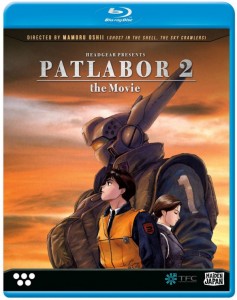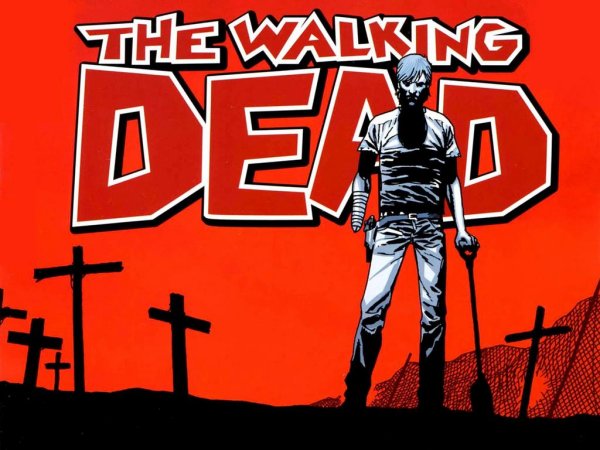 Sometimes you’re in the middle of a war without realizing just how long it’s been going on.
Sometimes you’re in the middle of a war without realizing just how long it’s been going on.
What They Say:
A rogue military jet bombs a Tokyo bridge. The city is in panic. But is it a real terrorist attack, the first stage of a coup, or the opening gambit of an even more Machiavellian plot? As the military attempts to take control and Martial Law is declared, the task of untwisting the complex web of secrets, lies, and betrayals falls to the convoluted mind of Captain Kiichi Goto.
But when the Defense Forces have been turned against each other and government itself may be suspect, who can he depend on as his ground troops in a bid to pull the country back from the brink of oblivion? The men and women of the SV2 and their mobile force of Ingram patrol robots, of course.
The Review:
Audio:
The audio presentation for this release is pretty simple compared to the last time it was on Blu-ray, which was with Bandai Visual USA as they mirrored the Japanese release to test and showcase what Blu-ray can do. Gone are all the mostly unnecessary tracks here with their varied encodings as we get just the original Japanese language track and the previously created English language mix using the DTS-HD MA lossless codec. While I could see some case being made for the original theatrical stereo mix to be included, it’s a very small number that will actually listen to it – or even notice that it’s not here. The Patlabor lossless presentation is a significant upgrade over the previous incarnations that have been released on DVD. The standard 5.1 mixes do seem a bit louder in the forward soundstage, but the depth and clarity of the mix gives it a much richer and deeper feel. There is a good deal of surround effects during the busier action sequences and it has some solid placement and clarity to it that you don’t get to the same level on the 5.1 mix.
Video:
Originally in theaters back in 1993, this film is is presented in an aspect ratio of 1.85:1 and is encoded using AVC. The transfer looks to be working with the same materials as we saw with the previous Blu-ray edition and that’s largely a good thing. What is most apparent with this transfer is that the dust and dirt on the cels are all the more apparent. This is significantly more at times than we saw in other high definition remasters at the time and is evident throughout outside of a few scenes. Beyond digitally cleaning it up and removing it, which in a lot of ways I think is a travesty, I doubt this film could look much better. Colors are vibrant and bold when required and the detail is all the more apparent and rich here. Unlike the DVD release from 2006, the black levels on this are a world apart in how well they look. There is a strong uniform feeling to it and it avoids coming across as blocky. The first few minutes of the film were very bad looking on the DVD release but here it looks as pristine as it can be.
Packaging:
The packaging for this release is simple and straightforward but it also manages to evoke the right mood. With the cover artwork, we get the Ingram in the background while Noa and Nagumo are in the foreground, but kept small in comparison, which is amusing since the trio as a whole is minimal in the feature. With the orange sunset of the sky here with the clouds, it has a good sense of twilight about it and the end of things, representing some of the theme of the film. The logo is done in a solid metallic style that works well and it makes the expected plugs for Mamoru Oshii. The back cover works in the same design style as previous Patlabor releases with pictures slotted along the left and right while the premise is well covered in the center with black text on a white block background. The timeline continues to be useful and solid to have here and we get it all rounded out with the production credits and technical grid.
Menu:
Not surprising is that the menu design works off of what the packaging design is as it essentially zooms in on that same image and lets it dominate the static screen. Where it works better here than the cover is that the color presentation is stronger and richer, making for a more engaging sunset but also clearer character designs along the bottom in the foreground. The logo is kept to the upper left while the lower left has the navigation menu which works in the same design as the TV/OVA series material did with its overall layout and approach. Since there’s not much here beyond the film itself, the chapter menu and the language selection is all we get otherwise and both load quickly and easily both as a top level menu and during playback as a pop-up menu.
Extras:
None.
Content: (please note that content portions of a review may contain spoilers)
While for a lot of fans of the franchise overall the first Patlabor film is their favorite, for me it’s the third and more recent one. But Patlabor 2 comes in very close, and with this renewed viewing now quite a few years after last seeing – and still seemingly seeing it a couple of times every decade, it’s a film that I think has even more relevance now. While the villains are largely a mystery, even towards the end of the final act, what it presents is something where the enemy is uncertain, intangible in a way, even as problems are caused within Tokyo and Japan in general. That sense of hopelessness is something that feels even more powerful this time around as it impacts the SV2 unit and what they have to face, particularly since like the other films, the team as a whole has a small role and it’s more about those in charge and some of the supporting cast.
That said, Patlabor 2 is very hard to describe without giving a lot away, as the movie is about peeling away the layers of society through the story and said society’s relationship with the outside world. Written as a near-future story with really only one element of science fiction (the Patlabors themselves, which are very underused in this movie), much of it can be seen as an insight into the psyche of a national consciousness and give some understanding to the thinking behind it. Having an avid interest in Japanese society and culture, I really find such stories to be among the most interesting.
The storyline is almost entirely dialogue driven with the exception of the final ten minutes or so. Some brief bits of action are scattered throughout, but they primarily serve the storyline and not vice versa. The bulk of the story also focuses on the two Captains of Section 2. Through investigation and the changing level of panic in the country, the two work their way towards unraveling who is behind the terrorist attacks. With Nagumo having a connection to the man that may be behind all of this, there’s some great ways in watching her dealing with it, going through it all professionally as can be, but also bringing some realization that that past may be what she was assigned to this reclaimed land mass and organization.
Goto himself continues to feel like he floats through the film, much as he does in the others and the TV series, but there’s a sharpness about him. His observational side in what he takes in is his biggest asset and as he ends up “working” with an Intelligence agent in order to get information, he realizes more and more of what’s going on. His style is what really draws you in because you can’t be sure of just what he’ll do, beyond trusting that his team will do what’s right. He’s also a great complement not only to Nagumo, but to the detective, Matsui. His role here is again similar to the detectives in the first film in how they ferret out information while providing a look at how Japan is amid this war that’s going on throughout the world, which they supply in various ways, but have no direct involvement in that challenges their moral aspect of it. Matsui’s the kind of character where I’ll easily admit that if I want a serious police procedural, he’s the kind of character I want to see in it.
There’s one particular segment that really stands out on this disc is about halfway into it. The city has fallen under control of the civil government who uses the military to take hold of it. The citizens watch what’s going on via their televisions and in the streets as the tanks and other personnel vehicles make their way throughout the city. Some of the soldiers are humanized, others are dangerous looking figures. All of this begins against the backdrop of a grim and gray fall season. As the sequence plays out, the days and nights get colder and the snows begin to fall in a most hypnotic fashion. The way it’s animated is gorgeous and blends quite well with the characters and the settings. Watching people walk through it, watching the tanks rolling by… the entire feel of the segment at this point is very somber. But it also feels even more relevant now as we see more and more people having accepted the things that are done, even as things are lost, and unable to push back against it. There’s some natural layering here that’s intriguing, even more so because the cultural identity is so different here because of the impact of their last war on the national consciousness, but a lot can be taken away and applied locally as well.
In Summary:
Re-watching the Patlabor films after finally seeing all of the TV series and OVAs within recent memory is definitely for the better. While there’s a disconnect between the TV and movie continuity, there are aspects you can carry through. When I had first seen the Patlabor movies, long before the other works, this second film is what made me a fan of it. There’s some really great storytelling going on here about the way society is able to play within the gray areas of responsibility towards its actions by interactions with other countries engaged in various wars, and what it means by the peace earned by it. There’s no real central character that drives the story here, but rather a story that drives a number of characters. And that makes it richer and more engaging as it progresses, being drawn in more as new connections are revealed and the scale of what’s underway is truly revealed. Not only does this movie age well, it’s still very relevant, if not more so, overseas than it was when it first came out. Very recommended.
Features:
Japanese DTS-HD 5.1 Language, English DTS-HD MA 5.1 Language, English Subtitles
Content Grade: A
Audio Grade: B+
Video Grade: B+
Packaging Grade: B+
Menu Grade: B
Extras Grade: N/A
Released By: Maiden Japan
Release Date: July 21st, 2015
MSRP: $39.98
Running Time: 107 Minutes
Video Encoding: 1080p AVC
Aspect Ratio: 1.78:1 Widescreen
Review Equipment:
Sony KDL70R550A 70″ LED 1080P HDTV, Sony PlayStation3 Blu-ray player via HDMI set to 1080p, Onkyo TX-SR605 Receiver and Panasonic SB-TP20S Multi-Channel Speaker System With 100-Watt Subwoofer.



